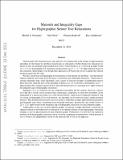Matroids and integrality gaps for hypergraphic steiner tree relaxations
Author(s)
Goemans, Michel X.; Olver, Neil; Rothvoss, Thomas; Zenklusen, Rico
DownloadGoemans_Matroids and integrality.pdf (533.9Kb)
OPEN_ACCESS_POLICY
Open Access Policy
Creative Commons Attribution-Noncommercial-Share Alike
Terms of use
Metadata
Show full item recordAbstract
Until recently, LP relaxations have only played a very limited role in the design of approximation algorithms for the Steiner tree problem. In particular, no (efficiently solvable) Steiner tree relaxation was known to have an integrality gap bounded away from 2, before Byrka et al. [3] showed an upper bound of ~1.55 of a hypergraphic LP relaxation and presented a ln(4)+ε ~1.39 approximation based on this relaxation. Interestingly, even though their approach is LP based, they do not compare the solution produced against the LP value. We take a fresh look at hypergraphic LP relaxations for the Steiner tree problem---one that heavily exploits methods and results from the theory of matroids and submodular functions---which leads to stronger integrality gaps, faster algorithms, and a variety of structural insights of independent interest. More precisely, along the lines of the algorithm of Byrka et al.[3], we present a deterministic ln(4)+ε approximation that compares against the LP value and therefore proves a matching ln(4) upper bound on the integrality gap of hypergraphic relaxations.
Similarly to [3], we iteratively fix one component and update the LP solution. However, whereas in [3] the LP is solved at every iteration after contracting a component, we show how feasibility can be maintained by a greedy procedure on a well-chosen matroid. Apart from avoiding the expensive step of solving a hypergraphic LP at each iteration, our algorithm can be analyzed using a simple potential function. This potential function gives an easy means to determine stronger approximation guarantees and integrality gaps when considering restricted graph topologies. In particular, this readily leads to a 73/60 ~1.217 upper bound on the integrality gap of hypergraphic relaxations for quasi-bipartite graphs.
Additionally, for the case of quasi-bipartite graphs, we present a simple algorithm to transform an optimal solution to the bidirected cut relaxation to an optimal solution of the hypergraphic relaxation, leading to a fast 73/60 approximation for quasi-bipartite graphs. Furthermore, we show how the separation problem of the hypergraphic relaxation can be solved by computing maximum flows, which provides a way to obtain a fast independence oracle for the matroids that we use in our approach.
Description
Original manuscript December 13, 2011
Date issued
2012-05Department
Massachusetts Institute of Technology. Department of MathematicsJournal
Proceedings of the 44th symposium on Theory of Computing (STOC '12)
Citation
Goemans, Michel X., Neil Olver, Thomas Rothvoss, and Rico Zenklusen. “Matroids and integrality gaps for hypergraphic steiner tree relaxations.” In Proceedings of the 44th symposium on Theory of Computing - STOC 12, 1161. Association for Computing Machinery, 2012.
Version: Original manuscript
ISBN
9781450312455